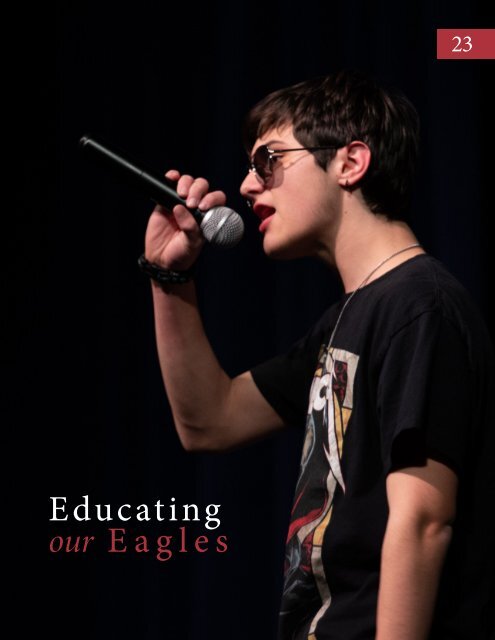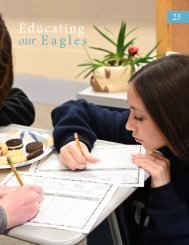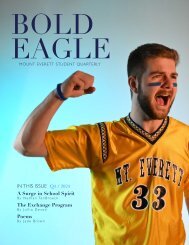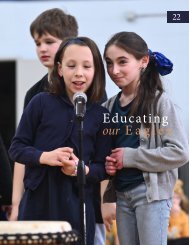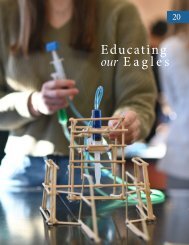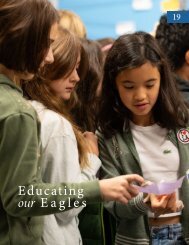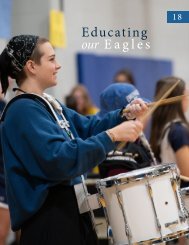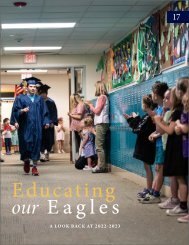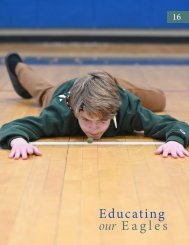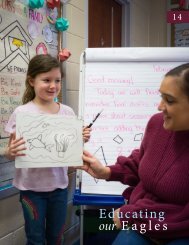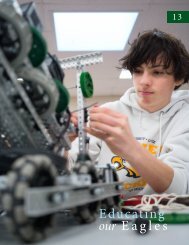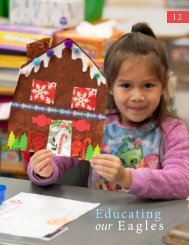Educating Our Eagles - Issue 23
You also want an ePaper? Increase the reach of your titles
YUMPU automatically turns print PDFs into web optimized ePapers that Google loves.
<strong>Educating</strong><br />
our <strong>Eagles</strong><br />
<strong>23</strong>
CONTENTS<br />
4<br />
Introduction - Curriculum Director, Julie Dolan<br />
6<br />
High School - Cabaret – Courtney English<br />
8<br />
Elementary School - Fascinating Rhythm – Elizabeth Petty<br />
10<br />
Middle & High School - Net Games – Josh King<br />
12<br />
High School - Keychain Design – James Siket<br />
14<br />
7th grade- Animal and Plant Adaptations – Lindsey Brown<br />
16<br />
11th & 12th grades– Probability Basics – Neal Barbieri<br />
Cover: Nick and company perform Beastie Boys’ “Fight For Your Right”<br />
during Mount Everett’s Cabaret.<br />
Right: Students in Ms. Giordano's Advisory sing Valentine-o-grams for<br />
their classmates. Aiden plays the saxophone solo on “Careless Whisper.”<br />
EDUCATING OUR EAGLES<br />
2
EDUCATING OUR EAGLES<br />
3
INTRODUCTION<br />
From SBRSD’s Director of Curriculum<br />
and Instruction, Julie Dolan<br />
March came in like a lion this year. Let’s hope it leaves like a lamb.<br />
I know we are all ready for some spring weather! A big part of<br />
the spring in schools is MCAS (Massachusetts Comprehension<br />
Assessment System).<br />
Students in grades 3-8 will be taking two sections for Math and ELA<br />
(English Language Arts). The Science MCAS will be taken in grade 5<br />
& 8. In 10th grade, students must pass ELA, Math, and the Science and<br />
Technology test to graduate. We need you to help us get students ready<br />
to be at their best when testing.<br />
The top things you can do to support your student are to:<br />
• make sure they come to school every day.<br />
• make sure they get a good night sleep.<br />
• eat a good breakfast.<br />
• tell them not to worry and just do their best!<br />
MCAS is part of the accountability system the state uses to evaluate<br />
our district's success. This makes the test important, but we realize it<br />
is just a snapshot of your child on one given day. This is why we have<br />
benchmark assessments through the year that show us a student's<br />
needs and growth so we can support them best in real time.<br />
Please read the emails that come home from your building<br />
administrators, so you know when your child has a MCAS test.<br />
All My Best,<br />
Julie Dolan<br />
Right: Ms. Petty's students practice rhythm in music class.<br />
EDUCATING OUR EAGLES<br />
4
5
HIGH SCHOOL:<br />
Cabaret<br />
Mount Everett’s CABARET returned to the stage this year! Students chose to work as a solo or<br />
small group and picked their own music to perform. Since returning from break in January,<br />
students rehearsed two days a week on their chosen pieces, with a check in from a teacher. As<br />
a class, they chose a date for the Cabaret, a format which included holding it in the TACPAC with a five<br />
dollar charge that would include refreshments that they provided, and they helped facilitate the whole<br />
evening. The students set up and ran the refreshments, they hosted the event, worked the backstage setup<br />
and change-over of each act, and were the clean-up crew at the end of the evening. They designed their<br />
own act down to what would be appropriate to wear for what they were performing.<br />
As a result of instruction, students will be able to:<br />
• time-manage and run a rehearsal with their piece of music over the course of five weeks.<br />
• take direction from an instructor to incorporate into their rehearsals pieces to make improvements.<br />
• start and end pieces on their own without a conductor.<br />
• work with an accompanist.<br />
• enter a stage as a soloist or ensemble, and properly bow (acknowledge applause) as well as<br />
acknowledge their pianist.<br />
• perform in a solo or small ensemble in front of an audience.<br />
MA Standards:<br />
Select, analyze and interpret artistic work for presentation. Contribute to the production of a small group<br />
performance (e.g., run a section of a rehearsal). (P.M.P.04)<br />
Develop and refine artistic techniques and work for presentation. Perform with accuracy and expression<br />
works from the vocal or instrumental literature with a level of difficulty of 3, on a scale of 1 to 6; or a<br />
comparable scale. (F.M.P.05)<br />
Convey meaning through the presentation of artistic work. Modify a performance by anticipating audience<br />
responses to better align to student's artistic intent. (P.M.P.06)<br />
EDUCATING OUR EAGLES<br />
6
EDUCATING OUR EAGLES<br />
7
ELEMENTARY SCHOOL:<br />
Fascinating Rhythm<br />
<strong>Our</strong> languages naturally reveal rhythm in the words that we speak. Using sentences and<br />
meaningful vocabulary, the syllables reveal a possible inspiration for a pattern of sound. As<br />
students prepare to read music notation, making their own in an improvised way, using a<br />
new language, allows them to share and record their own rhythm. As an exercise, these rhythms are<br />
written on staff paper and played on instrumentation chosen by the student composers.<br />
As a result of instruction, students will be able to:<br />
• understand the way rhythm can be translated - to be understood by another.<br />
• have an opportunity to improvise and compose.<br />
• recreate their rhythm (half, quarter and eighth notes) in physical form.<br />
• have an opportunity to share their work with others by having them try it out.<br />
Observations:<br />
We used large straws as manipulatives to replicate a pattern of half notes, quarter notes and eighth<br />
notes into a random playable/clappable order. The students dove right in to creating their own<br />
patterns. They enjoyed working alone as well as collaboratively. Some realized that the rhythm and<br />
sound they had planned is not what was “read” by their teammate(s). Some rhythms were pared down<br />
in order to be easier to remember and “catchier“ to play.<br />
MA Standards<br />
Creating, Performing, and Responding<br />
EDUCATING OUR EAGLES<br />
8
EDUCATING OUR EAGLES<br />
9
MIDDLE AND HIGH SCHOOL:<br />
Net Games<br />
The week prior to vacation students in Wellness 6, Wellness 1, and Lifetime Fitness<br />
(grades 6-12) had the opportunity the play a variety of different games related to net<br />
games. Students had the chance to use a variety of different implements to play games.<br />
Striking with an implement (also referred to as the two handed strike) involves applying force<br />
to an object using an implement. Those games included ping pong, badminton, tennis, and<br />
pickleball. Each game required different types of skills in striking with an implement and speed<br />
of the game itself based on their preference.<br />
As a result of instruction students will be able to:<br />
• choose an activity based on their interested skill level.<br />
• use a variety of different long or short handled implements (tennis racquets, pickleball<br />
paddles, badminton racquets, and ping pong paddles).<br />
• learn the various rules of each game.<br />
Observations<br />
The participation on all levels by the students worked well. Most of the students had the<br />
opportunity to experience a variety of different games and activities. I think for the majority of<br />
the students, they enjoyed the variety of choices of games they played. I was glad to see student<br />
involvement.<br />
MA Standards:<br />
2.12 Participate in activities that promote physical fitness, decrease sedentary lifestyle, and relieve<br />
mental and emotional tension<br />
2.14 Apply advanced movement concepts and beginning game strategies to guide and improve<br />
individual and team performance<br />
EDUCATING OUR EAGLES<br />
10
EDUCATING OUR EAGLES<br />
11
HIGH SCHOOL:<br />
Keychain Design Lesson<br />
Students in 3-D Printing and Design have been designing and printing their own<br />
key chain while learning 3-D software. Their designs include a variety of shapes,<br />
colors, and textures. Throughout this lesson, students will learn fundamentals<br />
of composition including positive and negative space to design a key chain with<br />
their name on it. Students will practice design elements by taking their idea from an<br />
isometric drawing and computer-aided model design, to a three dimensional final<br />
product - a functional printed key chain.<br />
As a result of instruction, students will be able to:<br />
• take an idea from a 2-D design to a 3-D design.<br />
• group and combine shapes in 3-D software.<br />
• use scale and proportions to have accurate measurements.<br />
• print with/on a 3-D printer.<br />
• complete an isometric drawing and understand its purpose.<br />
• save and export different file formats and format conversions.<br />
Observations:<br />
Students showed a good sense of design and layout. They were creative, and I am always<br />
impressed by the creative touches they think to add. This is a very popular project, as is<br />
it their first design printed with the 3D printer!<br />
MA Standards:<br />
HS-ETS2-1(MA). Determine the best application of manufacturing processes to<br />
create parts of desired shape, size, and finish based on available resources and safety.<br />
HS-ETS1-5(MA). Plan a prototype or design solution using orthographic projections<br />
and isometric drawings, using proper scales and proportions.<br />
EDUCATING OUR EAGLES<br />
12
EDUCATING OUR EAGLES<br />
13
MIDDLE SCHOOL:<br />
Animal and Plant Adaptations<br />
Seventh grade Science students study adaptations that organisms need for increased<br />
survival and reproduction in various habitats. To demonstrate their understanding,<br />
they create a project to show the behaviors or structures needed for increased<br />
survival and biological fitness within a chosen species. Students were able to research an<br />
existing plant or animal, or create a new species based upon inspiration from an existing<br />
adaptation. To show understanding, students could create: a diagram/drawing, a model,<br />
a written explanation, or a poster to show the relationship type, animal behavior(s)/<br />
structure(s), or plant structure(s), involved, habitat, and unique species related vocabulary.<br />
These projects were required to relate content vocabulary words, important plant/animal<br />
structures and relevant animal behaviors to our unit essential question, and to show clarity,<br />
organization, focus on topic, and understanding of content.<br />
As a result of instruction, students will be able to:<br />
• construct an explanation based on evidence for how characteristic animal behaviors<br />
and specialized plant structures increase the probability of successful reproduction of<br />
animals and plants.<br />
• explain how the structures and/or behaviors of organisms enable and enhance life’s<br />
functions.<br />
Observations:<br />
Students really showed their individuality and creativity with this assignment. They practiced<br />
their researching skills, evaluating and citing sources, and showed investment and focus on<br />
their projects. They also were able to gain a greater level of understanding of content and build<br />
in relevant examples of animal and plant adaptations to draw upon when thinking critically<br />
about the standard on future assignments and assessments.<br />
MA Standards:<br />
7.MS-LS1-4<br />
EDUCATING OUR EAGLES<br />
14
EDUCATING OUR EAGLES<br />
15
HIGH SCHOOL:<br />
Probability Basics<br />
Students in 11th and 12th grade Math were presented with the definition of probability<br />
and discussed sample spaces and events. Two major types of probability (theoretical<br />
and empirical) were discussed and explored. Students explored and provided<br />
examples of real-life scenarios to illustrate the different types. Common misconceptions<br />
were investigated such as that probability is always based on luck or chance, emphasizing<br />
that it can also be calculated using mathematical principles. Students then used empirical<br />
probability to make predictions and decisions regarding outcomes.<br />
As a result of instruction, students will be able to:<br />
• calculate probability, both theoretical and empirical and evaluate potential outcomes<br />
of a decision by allotting probabilities to payoff values and computing expected values.<br />
Observations:<br />
Students were using their knowledge of theoretical and empirical probability to make informed<br />
decisions based on the likelihood of events.<br />
MA Standards:<br />
Using Probability to Make Decisions<br />
A. Calculate expected values and use them to solve problems.<br />
B. Use probability to evaluate outcomes of decisions.<br />
EDUCATING OUR EAGLES<br />
16
EDUCATING OUR EAGLES<br />
17
EDUCATING OUR EAGLES<br />
18


